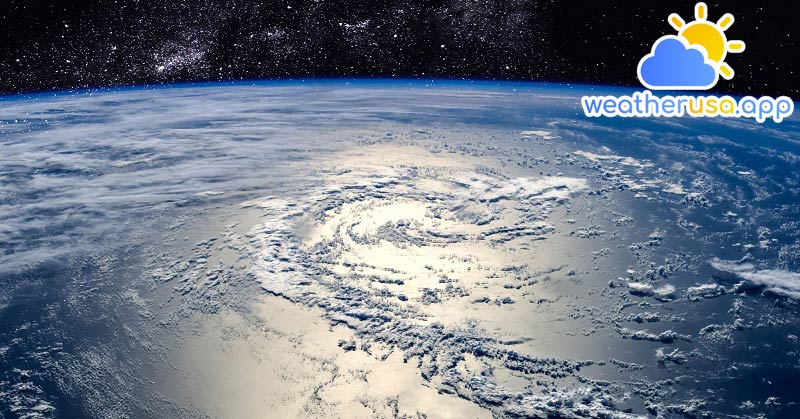
Earth’s Atmosphere
Earth’s Atmosphere
The composition of the Earth’s atmosphere.
Essay on the atmosphere near the earth: The atmosphere consists of many different gases, such as nitrogen, oxygen, and argon. The remaining insignificant amounts are carbon dioxide, masonry, helium, methane, hydrogen, ozone, etc.
There is always water vapor and other suspended impurities in the air. Air that does not contain water vapor and mechanical impurities are called clean and dry air.
The relative molecular mass of dry air is 20.97, roughly equal to the relative molecular mass of nitrogen.

Research using balloons and rockets has determined that the chemical composition of the air remains constant up to an altitude of 90-100 km.
At the same time, the molecular mass of the air does not change almost in that gas layer, so the gas layer is said to be homogeneous.
The vertical and horizontal air exchange explains the stability of the atmospheric composition in a homogeneous gas layer.
- Water vapor can escape from the water surface, damp ground, vegetation, etc. evaporates into the atmosphere. The amount of water vapor decreases very quickly as the altitude increases.
The presence of water vapor slightly changes the composition of the air. Water vapor plays an essential role in the atmosphere. Due to condensation and frost, clouds, rain, snow, fog, etc., reduce the viewing distance.
In addition, water vapor also absorbs the earth’s long-wave radiation, affecting the atmosphere’s thermal regime. - Carbon dioxide enters the atmosphere from fires, decay, decomposition of organisms, breathing of animals… Carbon dioxide amounts vary according to conditions, locality, time of day, and year’s season.
As the amount of carbon dioxide increases, the temperature of the air near the ground increases. - Ozone gas – gas consisting of three oxygen atoms. Thunderstorms in the lower layers of the atmosphere produce ozone.
In the upper layers of the atmosphere, ozone is created due to the interaction of the sun’s ultraviolet rays with oxygen.
Ozone’s leading and crucial role in life on earth is its ability to absorb solar ultraviolet radiation. Ozone gas can absorb 4% of the sun’s rays, increasing the air temperature at an altitude of 20-50 km.
High altitude atmospheric composition: From a size of 90-100 km or higher, the design of the atmosphere changes sharply.
Over 100 km, monatomic oxygen is observed, and over 300 km, some nitrogen is decomposed. At altitudes above 1000 km, the atmosphere consists mainly of helium and hydrogen.
Atmospheric structure
Atmospheric height and mass. Under gravity, the air density is more significant in the layer closest to the ground.
As the altitude increases, the density decreases. Gradually the density of air approaches the density of space.
Today, it is tentatively accepted that the upper physical limit of the earth’s atmosphere is at an altitude of 2000 km.
The total mass of the atmosphere is equal to 5.16 x 10 g. About 50% of the pack is at an altitude of 5 km, 75% in the layer up to 10 km thick, and 90% in the layer up to 16 km division of the atmosphere into layers.
The division of the atmosphere into layers. The study of the phenomena observed in the atmosphere shows that it can divide the atmosphere into a series of concentric spheres. This distinction follows different principles.
According to the characteristics of the temperature change due to altitude, and especially about the internal temperature regime of each layer, the atmosphere is divided into the following five main layers. See Table 1.
| Floors (bridge layer) | Average altitude, km | Transition classes |
| Troposphere (tropos) | 0-11 | The term convection layer (tronpopauso) |
| The stratosphere (the stratus) | 11-50 | The term stratopause layer (stratopause) |
| Intermediate layer (mezos) | 50-80 | The term mezo layer (mezopause) |
| The thermosphere (termos) | 80-800 | The term termopause layer (termopause) |
| Outer atmosphere | over 800-2000 |
- Troposphere: The remarkable thing about the troposphere is that the temperature drops with altitude. The average temperature reduction is about 6-7° at 1 km altitude.
There is always water vapor, clouds, rain, snow, and fog in the troposphere… In the troposphere, the winds are predominantly westward at mid and high latitudes, and the wind intensity increases as you go up.
Reached its maximum value close to the upper limit. Air pressure drops sharply with altitude, and at an altitude of 5 km, the residual stress is 1/2. At a length of 10 km, it is 1/4 of that at ground level.
The height of the upper troposphere boundary is not constant. It depends on the year’s season and the atmospheric processes’ specificity.
From winter to summer and from the poles to the equator, an increase in the upper limit of the troposphere is observed. - Stratosphere: It is the transition layer between the troposphere and the stratosphere. The thickness of this layer is about 1-2 km. In periodic convection, the temperature stops falling with altitude.
The main feature of the stratosphere is temperature stability with altitude in the lower part and an increase in size starting from 25 km to the upper limit.
At the upper limit of the stratosphere, the temperature rises to 0° and can grow to +10° or even +30°.
This is explained by the excellent absorbency of ozone, the mass of which is in this layer. In the stratosphere, water vapor is rare and almost cloudless. - Intermediate layer: The transition layer between the stratosphere and the mesosphere is called the stratosphere. The temperature in the mesosphere decreases with altitude.
At the upper limit of this layer, the temperature drops to minus 70, minus 80°. The interlayer is characterized by substantial distortion and vertical distortion. The air density here is negligible.
At the upper limit of this stage, the air pressure is about 200 times less than the pressure above ground. Wind speeds reach several hundred kilometers per hour.
At an altitude of about 82-85 km, silver clouds are sometimes observed consisting of tiny ice crystals. - Thermosphere: The characteristic of this layer is that the temperature increases with altitude, which is related to the absorption of solar energy by oxygen atoms.
According to calculations, the temperature at the upper limit can reach 750-1500°. Of course, this temperature cannot be measured. The thermosphere is extremely thin. - Outer atmosphere: The air temperature in this layer can reach even higher values than in the heating layer.
The movement of light gases, such as hydrogen and helium, into interplanetary space at incredible speeds can come at 11.2 km/s and overcome the earth’s gravity.
In addition to dividing the atmosphere into five layers according to the thermal situation above, humans also divide it according to electrical properties. In this way, the thermosphere is called the ionosphere.
For most of the thickness of the ionosphere, there are atoms and molecules of various gases in large densities.
The ionosphere is further divided into three layers according to their effects on radio wave propagation. It is class D, E class, and F class.
In the ionosphere, the aurora phenomenon and the glow of the sky are often observed at night.
Weather 01852 - Lowell MA

58°
clear sky
Feels like 57°05:36/19:47
62°F
/52°F
65%
1021 hPa
7 mi
6.91 mph



